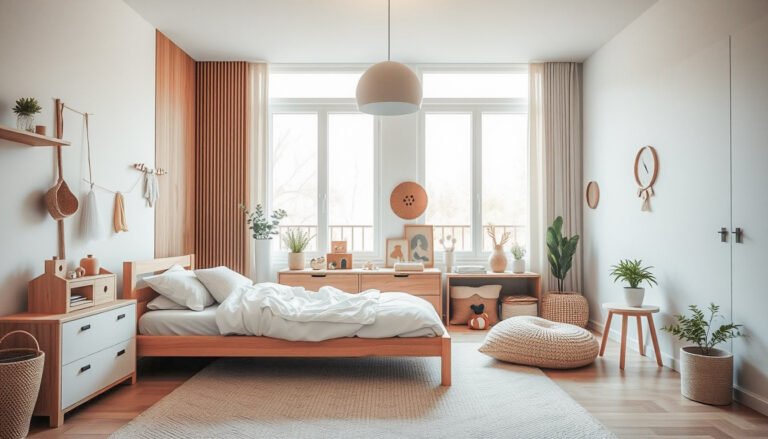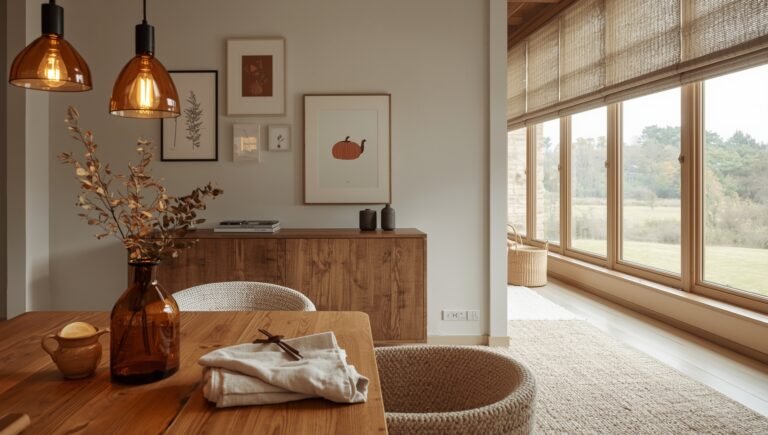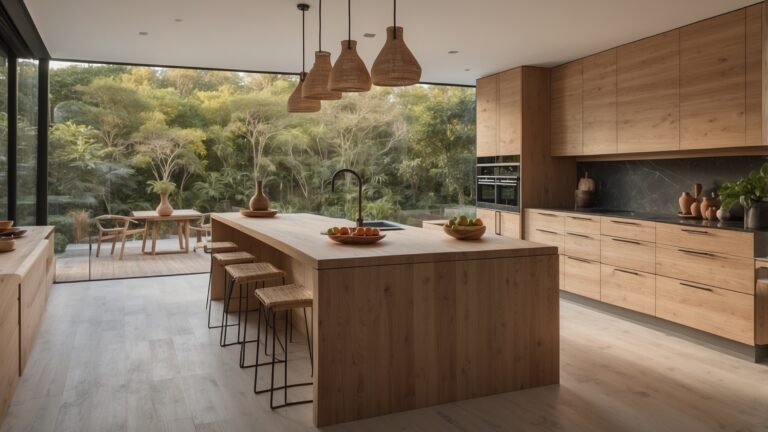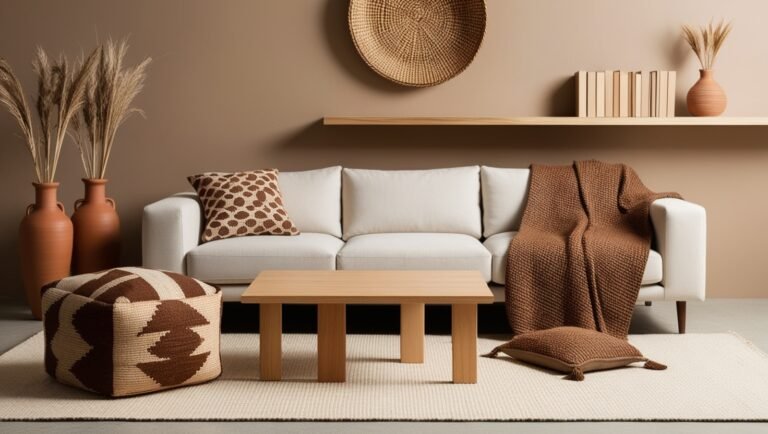Nordic-Japanese Green Walls: biophilic Vertical Garden Systems
Do you feel trapped in the city? Urban life often means little green around us. This makes our homes feel far from nature.
Nordic-Japanese Green Walls mix Scandinavian simplicity with Japanese peace. They use plants to cover walls, inspired by old designs and new science. The Morelle House shows how, with green walls in courtyards.
These walls use calm colors and natural stuff, like wood and stone. They make spaces feel calm and clean the air. They also help keep places cool or warm.
Key Takeaways
- Nordic-Japanese Green Walls combine minimalist design with organic aesthetics.
- Vertical garden systems like those in the Morelle House enhance indoor-outdoor harmony.
- These systems boost air quality and energy efficiency in urban settings.
- Japandi principles prioritize natural materials and neutral palettes for calming spaces.
What Are Nordic-Japanese Green Walls?
Imagine a living wall that mixes Scandinavian design with Japanese gardening. These walls blend plants and architecture. They change spaces by adding beauty and function.
The Concept Behind Green Walls
Vertical garden systems have been around for a while. But Nordic-Japanese designs make them special. They turn walls into living art, combining beauty with usefulness.
These systems use smart water systems and strong materials. They work well in homes or offices. The aim is to bring nature inside without losing style.
The Fusion of Nordic and Japanese Aesthetics
This mix combines Nordic simplicity with Japan’s love for nature. Scandinavian designs meet Japanese moss or bamboo. The outcome is Japandi spaces where plants grow in simple settings.
Every part, from stones to plants, shows a balance between culture and nature.
Benefits of Nordic-Japanese Green Walls
seen how Nordic-Japanese green walls change spaces. They bring green wall benefits that boost well-being and design. They’re not just decorations; they’re living systems that make spaces healthier, look better, and are more sustainable.
Environmental Advantages
Green walls clean the air by removing toxins like formaldehyde and VOCs. They also increase oxygen levels. They cut down energy use by 10-15% by keeping spaces warm in winter and cool in summer.
They also help cities by providing homes for insects and birds.
Aesthetic Appeal
Interior vertical gardens add texture and color to any room. Their simple Nordic design and Japanese plants make spaces calm and lively. Spaces with these gardens feel bigger and welcoming, mixing nature’s greens with modern or traditional decor.
Health Benefits of Indoor Gardening
Studies show these living walls lower stress hormones like cortisol by up to 25%. The design encourages mindfulness and caring for plants improves focus. In offices, they make workspaces calm, leading to 15% higher productivity.
Key Features of Nordic-Japanese Green Walls
Nordic-Japanese green walls mix new ideas with old traditions. They are both useful and beautiful, with a simple, natural look. Let’s look at what makes them special.
Vertical Plant Systems
These systems start with panels or mats that stick to walls. They use strong materials like polypropylene and geotextiles. This way, plants grow up, saving space and looking great.
Plants do well in these setups, both inside and outside.
Smart Irrigation Solutions
Smart watering systems are a big plus. They watch the soil and water it just right, saving water. This fits with living green, using less resources.
Users can control it all with apps. This means plants stay healthy without needing constant care.
Customization Options
These systems let you choose plants and designs. Pick easy-to-care-for plants like snake plants or ferns for a Japandi look. Change panel sizes or add stones for more texture.
This makes any space, big or small, feel calm and green.
Plant Selection for Green Walls
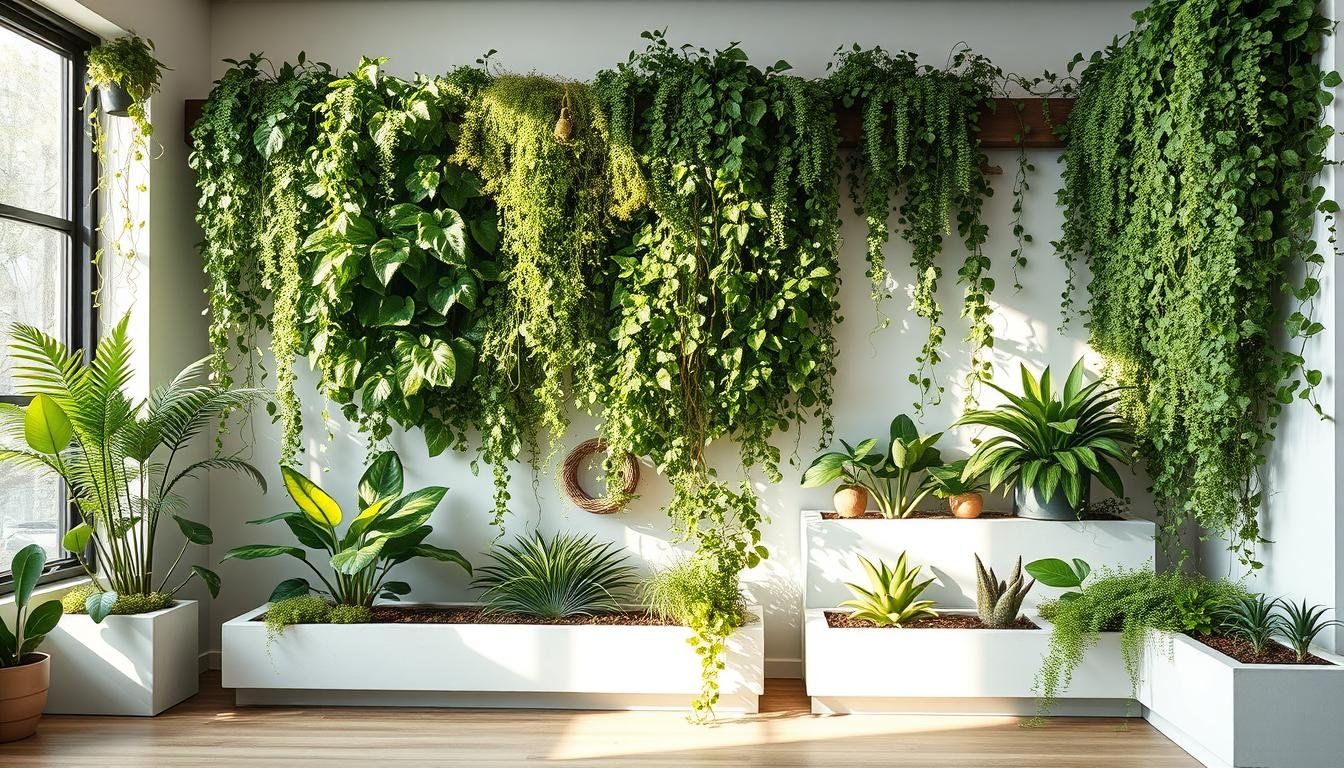
Choosing the right plants for green walls is crucial. They should thrive vertically and look good. Plants like Sedum or Pothos work well because they have shallow roots and grow compactly.
This mix of looks and function is key. It makes green walls a great addition to any space. The image below shows how plants can balance form and function.
Choosing the Right Plants
Plants with fibrous roots, like Saxifraga and Philodendron, stick well to vertical walls. For a simple look, Ficus Bonsai has shiny leaves. Kokedama moss balls bring a touch of Japanese art.
Japanese Maples change colors with the seasons. This fits well with the natural beauty of Nordic-Japanese Green Walls.
Seasonal Planting Considerations
Use evergreens like Fatsia Japonica with deciduous plants for interest all year. In cold months, plants like Rhipsalis Paradoxa do well in indirect light. In spring, add Peace Lilies to clean the air and bloom softly.
This way, green walls stay interesting all year. They don’t lose their green appeal.
Edible Plant Options
You can add herbs like basil or small veggies like cherry tomatoes to your green wall. They’re useful and don’t look bad. Trailing strawberries or rosemary add texture and taste.
Pairing these with ferns creates layers. This honors both traditions and supports green walls.
Maintenance Tips for Green Walls
Keeping your Nordic-Japanese green wall in top shape is easy. Just check on it 3-4 times a year. These vertical garden systems keep your air clean and your space looking great. You don’t need to watch them all the time.
Regular Care Routines
Remove dead leaves and swap out old plants every few months. Plants like Pothos or Philodendron need little care. Make sure the water system works right to avoid too much water.
Trimming now and then keeps things neat and encourages growth.
Pest Management Strategies
Stop pests before they start. Clean leaves weekly to keep pests away. If pests show up, use ladybugs or neem oil instead of harsh chemicals.
Quickly remove any affected leaves to keep the wall and air clean.
Seasonal Maintenance Tasks
In summer, water less because it’s hotter. In winter, water less and use LED grow lamps for light. Prune plants seasonally to keep the design looking good.
Designing Your Nordic-Japanese Green Wall
Start by understanding how green walls mix nature and function. My method brings plants and structure together. This creates calm spaces that grow well anywhere.

Space Considerations
First, check if the wall gets enough light and is stable. Choose walls facing north or east for most plants. Make sure the structure can hold the green wall system. Pick spots where the wall is the main feature but doesn’t take over.
Color Palette and Style
Nordic-Japanese style loves soft colors like greens, grays, and warm woods. Mix plants with simple fabrics like linen. Use terracotta pots for a nice contrast. Choose plants with different textures, like ferns and succulents, to add interest without mess.
Integrating Art and Décor
Add natural touches like bamboo or stone planters to follow biophilic ideas. Hang simple sculptures or ceramic art near the wall. This starts a conversation between the art and the green wall. Add organic items like woven baskets or driftwood to connect indoors with outdoors.
Sustainability in Nordic-Japanese Green Walls
Nordic-Japanese green walls combine beauty with care for the planet. They focus on eco-friendly living walls in modern design. These systems use materials that are good for the environment, like recycled plastics and biodegradable soils.
By using plants grown locally, they also help the environment. This choice cuts down on emissions from transportation. Plus, it helps bring more life to urban areas.
Eco-Friendly Materials
Materials like charred wood and recycled composites last longer. This means they need to be replaced less often. The Japandi style is all about lasting beauty without waste.
Even the sustainable greenery solutions are organic. They avoid harmful chemicals that can hurt our ecosystems.
Supporting Local Ecosystems
Native plants in these walls help pollinators in cities. They also soak up rainwater, which helps prevent flooding. This follows the Japanese wabi-sabi philosophy, which values nature’s beauty.
Energy Efficiency Benefits
These walls can save 15–30% on energy costs. They keep the air cooler by releasing moisture. Studies show they can even cut HVAC costs by up to 20%.
Creating a Zen Space with Green Walls
Imagine a room where greenery whispers calmness. It blends nature’s essence with simple design. Nordic-Japanese Green Walls turn spaces into peaceful places. They mix Japanese Zen with Nordic simplicity, bringing calm and clarity.
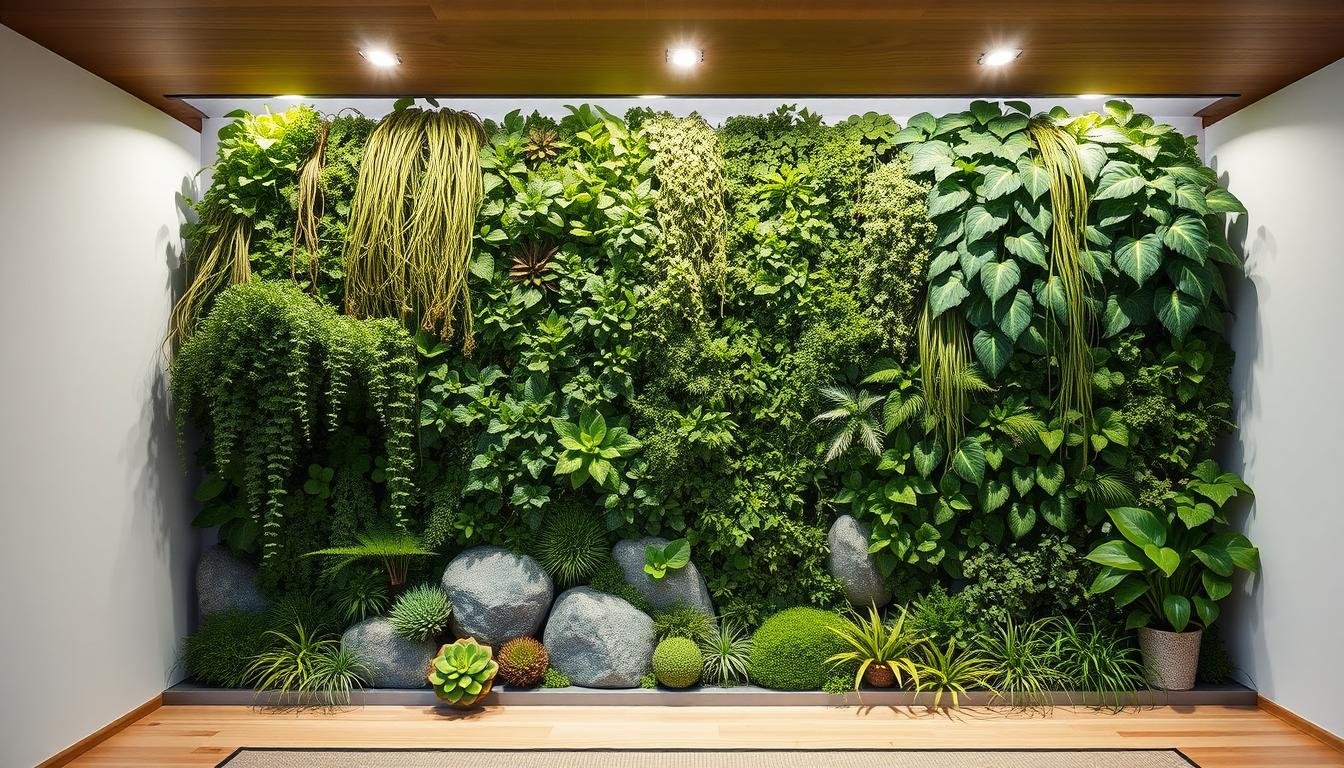
Meditative Benefits of Plants
Plants like bamboo or moss grow well in vertical systems. Their textures and colors remind us of nature. Studies show these Nordic-Japanese Green Walls can lower stress by 20-30%.
Using plants with a sage tone and simple designs follows Japanese wabi-sabi. It teaches us to find peace in simplicity and imperfection.
Designing a Relaxing Environment
Use neutral colors with touches of gold or driftwood for calm. Add ferns and ivy for depth without mess. Natural materials like bamboo or stone ground the space.
Indirect lighting, like dawn’s soft glow, adds to the peace. Open layouts and low furniture help energy flow, fitting Nordic style.
Incorporating Water Features
A small fountain or misting system near a green wall enhances the Zen feel. The sound of water and leaves creates a calm experience. Placing these near big windows lets in natural light, making the space even more peaceful.
The Role of Technology in Green Walls
Technology is changing vertical gardens into smart, green spaces. Companies like Naava are at the forefront. They use new tech like modular panels that clean the air, thanks to NASA research.
Their systems will be made in New Jersey by 2024. They mix recycled materials with nature-inspired designs. This makes indoor spaces better.
Smart Garden Systems
Today’s vertical gardens have sensors for moisture, nutrients, and light. Naava’s tech, made with Delos, helps plants grow well with less resources. They use special panels and fabrics to help roots grow and save water.
Monitoring Plant Health
Now, apps let you check on your plants from anywhere. Sensors find problems like nutrient gaps or pests. They send alerts to your phone.
This info helps keep plants healthy, even in small city areas.
Automation in Irrigation
Automation cuts down on manual work. AI-powered drip systems adjust water based on plant needs. This saves water.
Materials like APP membrane and acrylic coatings help water drain well. Plants like Pothos and Philodendron do great in these systems. Future studies will look at how these systems fight air pollution.
Case Studies: Successful Installations
Seeing biophilic architecture in action shows how green walls change spaces. Let’s look at real examples where these walls made a big difference.

In Seattle, a family turned a dark basement into a green oasis. They used modular green wall systems. They picked plants that grow well in low light, like pothos and ferns.
This made a peaceful spot. They also saved 30% on water by adjusting the irrigation. Plus, the air quality got better.
In Chicago, a building added a green wall to its lobby. They used tough succulents and LED lights. This cut stress by 25%, as shown in wellness surveys.
The green wall also tells the company’s story. It shows their commitment to the environment.
In Denver, a school put up an outdoor green wall. It uses native plants and flowers that don’t need much water. This helps students learn about nature.
It also cools the area by 5 degrees. Local nurseries helped with the plants, supporting local plants.
Every project shows how green walls meet different needs. They can improve mental health, save energy, or bring people together. These stories show how versatile green walls are in today’s world.
Frequently Asked Questions
Do you still have questions about green walls or interior vertical gardens? I’ll answer the most common ones. These answers cover setup, plant care, and costs. This will help you decide if these systems are right for your space.
Common Concerns About Installation
First, check the wall’s weight limit. Most setups need brackets or frames for safety. Waterproofing is key, using membranes in wet areas like bathrooms or kitchens.
For interior gardens, choose light plants like pothos or ferns. They don’t weigh much. Use bamboo or wood panels for durability and a natural look.
Troubleshooting Plant Issues
Yellow leaves mean you’re watering too much. Check the soil moisture first. Pests like spider mites can be treated with neem oil sprays.
Uneven growth might mean plants need more light. Regular trimming keeps your garden balanced.
Costs Involved
Costs vary a lot. DIY setups start at $200, while pros can charge $5,000+ for big spaces. Green walls save energy and improve air quality, making them cost-effective over time.
Commercial projects can see a return on investment. This is due to happy tenants and lower HVAC costs.
Getting Started with Your Own Green Wall
Ready to make your space greener with Nordic-Japanese Green Walls? Let’s get started. First, check your space’s structure and light. This style mixes Nordic simplicity with Japanese beauty, focusing on plants and architecture.

Planning Your Project
Draw a plan, noting walls that hold up the roof and where to find water. Choose plants that don’t need much water, like ferns or bamboo. Remember to budget for waterproofing and drip irrigation to keep your wall dry.
Resources and Supplies Needed
Buy modular planters and organic soil. Use bamboo mats or plaster-backed frames for a green wall. Place plants near windows for sunlight. Find suppliers who use eco-friendly materials.
Finding Local Experts
Look for local garden centers or landscape architects who know vertical gardens. Check their reviews for experience with Nordic-Japanese designs. Many nurseries offer workshops on caring for your green wall.
Start with a small section to test it out. Use smart sensors or simple checks to keep plants healthy. With careful planning and the right materials, your green wall will be a peaceful spot that changes with the seasons. It’s a mix of Nordic simplicity and Japanese nature that’s good for both plants and people.
FAQ
What are Nordic-Japanese Green Walls?
Nordic-Japanese Green Walls are new vertical garden systems. They mix Scandinavian simplicity with Japanese beauty. They look amazing and help the environment.
What are the environmental advantages of incorporating green walls?
Green walls clean the air, take in carbon dioxide, and release oxygen. They also make the air inside better. Plus, they keep buildings cooler, saving on energy costs.
How do I choose the right plants for my green wall?
Pick plants that grow small, handle stress well, and fit your style. This makes your green wall look good and stay healthy.
What maintenance is required for a Nordic-Japanese Green Wall?
You need to check the water, trim plants, fight pests, and adjust for seasons. This keeps your green wall looking great.
How can I design a Nordic-Japanese Green Wall?
First, think about the light and colors. Add natural stones or wood for a calm look. This makes a peaceful space.
What sustainable materials are used in these green walls?
They use recycled plastic, natural soil, and local plants. This helps the planet and supports local life.
How can I create a calming environment with a green wall?
Use plants and sounds to calm the mind. Arrange plants well and add textures and sounds. This makes a peaceful place.
What role does technology play in maintaining green walls?
Tech helps with smart gardens. It checks plant needs and waters them automatically. This makes caring for green walls easy.
Have there been successful implementations of Nordic-Japanese Green Walls?
Yes, many green walls have changed homes and offices. They also help communities. They look good and are good for health.
What should I consider when getting started with my own green wall?
Plan well, get the right stuff, and set a budget. You might also need help from experts. This makes starting a green wall easier.
The Bottom Line
Nordic-Japanese green walls beautifully merge the best of both design philosophies to create biophilic vertical gardens that enhance any space. Emphasizing simplicity, natural elements, and mindful craftsmanship, these living walls bring tranquility and a refreshing connection to nature indoors. Integrating sustainable plant choices and clean lines, they improve air quality and wellbeing while adding elegant, timeless greenery to modern interiors.

ABOUT the AUTHOR
TOKI; INTERIOR DESIGN & lifestyle CONTENT CREATOR.
Hey there! I’m Toki—the design-obsessed brain behind Dwell Studio 24. I’m a content creator passionate about interior design, photography, and creativity, living in a 77-year-old house with my husband and our awesome three kids. I write about interior design, furniture, home topics, and my lifestyle, including travel, recipes, skincare, and daily routines. I hope to inspire your next project and lifestyle!
ABOUT the AUTHOR
TOKI; INTERIOR DESIGN & lifestyle CONTENT CREATOR.

Hey there! I’m Toki—the design-obsessed brain behind Dwell Studio 24. I’m a content creator passionate about interior design, photography, and creativity, living in a 77-year-old house with my husband and our awesome three kids. I write about interior design, furniture, home topics, and my lifestyle, including travel, recipes, skincare, and daily routines. I hope to inspire your next project and lifestyle!
ABOUT the AUTHOR
TOKI; INTERIOR DESIGN & lifestyle CONTENT CREATOR.

Hey there! I’m Toki—the design-obsessed brain behind Dwell Studio 24. I write about interior design, furniture, home topics, and my lifestyle, including travel, recipes, skincare, and daily routines. I hope to inspire your next project and lifestyle!








